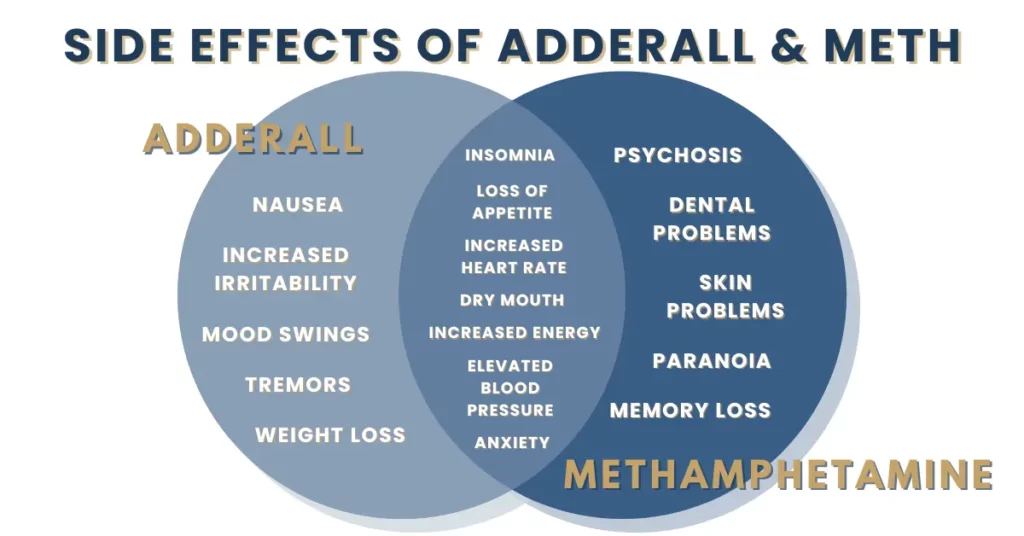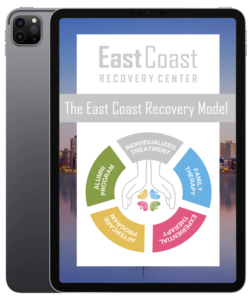Many individuals familiar with the world of stimulants may have asked, “Is Adderall like meth?” While both substances fall under the category of stimulants and share side effects on the mind and body, there are still questions about the differences between the two. By understanding the differences between these drugs, individuals can make informed decisions about taking Adderall and how it may affect their bodies and minds.
This article aims to answer the question, “Is Adderall like meth?” By understanding what Adderall and methamphetamine are, their side effects, and their similarities, we are able to answer that question and more.
Adderall vs. Methamphetamine
To properly understand the differences between Adderall and methamphetamine, commonly known as meth, we must first understand how the substances work independently. While Adderall and methamphetamine share some similarities, they are fundamentally different substances that can cause varying health risks and substance use disorders.
Understanding Adderall
Adderall is a prescription medication primarily used to treat attention deficit hyperactivity disorder (ADHD) and narcolepsy. It consists of a combination of dextroamphetamine and levoamphetamine, working together to enhance the levels of dopamine and norepinephrine neurotransmitters in the brain.
When taken as prescribed, Adderall is administered in controlled doses tailored to an individual’s specific needs. It enhances focus, attention, and impulse control in individuals with ADHD, allowing them to manage their daily tasks and responsibilities better. For those with narcolepsy, Adderall helps combat excessive drowsiness.
Understanding Methamphetamine
Methamphetamine is a powerful and highly addictive central nervous system stimulant drug belonging to the amphetamine family. While meth can be used to treat certain medical conditions, it is most commonly used as an illicit substance that overshadows the medical uses. Meth is illegally sold on the street, known as crystal meth, and can be smoked, snorted, or injected.
Methamphetamine’s primary mechanism of action involves a dramatic release of dopamine in the brain, significantly more intense than what occurs with Adderall. This sudden surge in dopamine creates intense euphoria and pleasure, leading to a rapid development of tolerance and addiction.
Read More: Meth-Induced Psychosis: Signs, Symptoms, & Treatment Options
The Dangerous Side Effects of Both Drugs
Both Adderall and methamphetamine have dangerous side effects that can result from abuse. By understanding these side effects, individuals can gain insight into how the two substances affect the body. Adderall and meth share many similar side effects, and some of the most common ones include the following:
- Increased heart rate
- Loss of appetite
- Insomnia
- Elevated blood pressure
- Dry mouth
- Anxiety
- Increased energy
While those are the side effects that are shared between the two substances, the specific side effects of Adderall may include the following:
- Nausea
- Increased irritability
- Mood swings
- Tremors
- Weight loss
The specific side effects of meth may include the following:
- Psychosis
- Dental problems
- Skin problems
- Paranoia
- Memory loss
Is Adderall Like Meth?
Yes, Adderall can be compared to meth since they have similar chemical structures, leading to common stimulant effects. Both substances also have the potential for misuse and addiction, particularly when taken in higher doses or not as prescribed.
However, a significant difference between the two is their risk profiles, as methamphetamine is considered one of the most potent and addictive stimulant drugs. This is due to the range of severe physical and mental health conditions that can arise when meth is abused. Adderall, in contrast, can be habit-forming and addictive, but its potential for abuse and the severity of the side effects are lower than methamphetamine.
Learn More: One Vice To Another: A Guide To Cross Addiction
Statistical Differences Between Adderall & Meth
Statistical differences between Adderall and meth can be found in various aspects, including usage patterns and demographics of users. These statistics showcase the shifts in drug use over time and their availability, showcasing the prevalence of addiction treatment and drug education.
- Usage Patterns: According to the National Survey on Drug Use and Health (NSDUH), in 2021, an estimated 1.3% (3.7 million) of individuals aged 12 and older reported non-medical use of prescription drugs, which includes Adderall. This is a 3.3% decrease from 2019. Methamphetamine, on the other hand, reported a lower overall usage pattern of past-year meth use, with an estimated 0.9% (2.5 million) of individuals aged 12 and older using methamphetamine in 2021. This is a 0.5% increase from 2019.
- Demographics of Users: According to NSDUH, the percentage of use for Adderall was most prevalent among college students and young adults aged 18 to 25 at 3.7% (1.2 million) in 2021. Additionally, the percentage of individuals who misused prescription stimulants like Adderall was highest among multiracial individuals at 3.1%. Meth use has historically been associated with misuse form white adults in rural areas. The data from NSDUH shows that meth use is most prevalent in individuals aged 26 or older, with 1.1% (2.3 million) individuals using meth in 2021. Similarly to Adderall, meth was most commonly used by multiracial individuals at 1.6%.
Adderall & Meth Addiction Treatment
Addiction to substances like Adderall and methamphetamine can devastate individuals and their families. Fortunately, effective addiction treatment options can help individuals overcome their dependency on these drugs. It’s important to note that treatment approaches may differ depending on the specific substance, the severity of the addiction, and individual needs.
The key to successful recovery from Adderall and meth addiction is an individualized treatment plan that addresses the individual’s needs and support and guidance from medical professionals at a treatment center. Once an individual is at a treatment center for their Adderall or meth addiction, they will begin their treatment plan. These plans typically involve:
- Medical Detox: This is the first step in achieving recovery as it removes the substances from the body. Medical detox provides a safe environment for individuals to go through the withdrawal symptoms, as they may become life-threatening.
- Behavioral Therapies: Behavioral therapies are utilized once the individual has completed the detox process. These therapies may help individuals identify triggers, thought patterns, and addictive behaviors. The therapies also allow individuals to develop coping mechanisms to address these behaviors and control drug cravings.
- Support Groups: Support groups, such as Narcotics Anonymous (NA), provide a community of like-minded peers for individuals in recovery. These groups offer a way for individuals to share their experiences and learn from others who have faced similar challenges.
Substance Abuse Treatment in Boston, MA
Individuals who are abusing Adderall or methamphetamine are experiencing a substance use disorder, whether they are aware of it or not. When experiencing a substance use disorder, it’s essential to receive the proper treatment to achieve life-long sobriety.
At East Coast Recovery Center, located in Boston, MA, we provide holistic addiction treatment and mental health services to individuals struggling with substance abuse. Our addiction treatment services encompass various therapy and treatment options, giving our clients the resources for their every need. At East Coast, we understand that addiction is unique to each individual, and we encourage our clients to disconnect from themself and reconnect with a community.
If you or a loved one are struggling with substance abuse, contact us today to learn more about our treatment programs.













